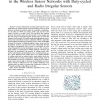Free Online Productivity Tools
i2Speak
i2Symbol
i2OCR
iTex2Img
iWeb2Print
iWeb2Shot
i2Type
iPdf2Split
iPdf2Merge
i2Bopomofo
i2Arabic
i2Style
i2Image
i2PDF
iLatex2Rtf
Sci2ools
ICC
2011
IEEE
2011
IEEE
The Insights of DV-Based Localization Algorithms in the Wireless Sensor Networks with Duty-Cycled and Radio Irregular Sensors
—Location information of nodes is the basis for many applications in wireless sensor networks (WSNs). However, most previous localization methods make the unrealistic assumption: (i) all nodes in WSN are always awake and (ii) the radio range of nodes is an ideal circle. This overlooks the common scenario that sensor nodes are duty-cycled to save energy and the radio range of nodes is irregular. In this paper we revisit the Distance-Vector-based (DV-based) positioning algorithms, particularly, Hop-Count-Ratio based Localization (HCRL) algorithm and investigate the following problems: (i) How is the relationship between the number of sleeping neighbor sensor nodes and the localization accuracy and (ii) How is the relationship between the degree of irregularity (DOI, which is a parameter of radio range irregularity) and the localization accuracy. We conduct a large number of experiments in WSNs simulator NetTopo, and find that the parameters: the number of waking nodes, DOI, anchor nod...
Related Content
| Added | 24 Dec 2011 |
| Updated | 24 Dec 2011 |
| Type | Journal |
| Year | 2011 |
| Where | ICC |
| Authors | Yuanfang Chen, Lei Shu, Mingchu Li, Ziqi Fan, Lei Wang 0006, Takahiro Hara |
Comments (0)

